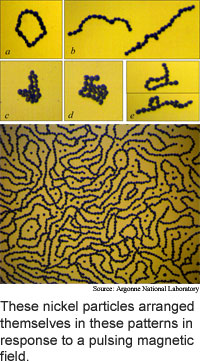
Magnetics drives particle patterns
Researchers from Argonne National Laboratory
have devised a way to use electric and magnetic fields to assemble magnetic
microparticles into a wide variety of patterns, including clusters, rings,
chains and networks.
Particular shapes depend on the amplitude, or strength, and frequency,
or vibration rate, of the magnetic field.
In general, low-frequency magnetic fields make the microparticles
form compact clusters, while high frequencies drive the microparticles
into chains and net-like patterns.
The researchers' work is one of several efforts aimed at finding
ways to cause particles to self-assemble in order to make microscopic
machines, smaller electronics and materials with precisely tuned properties,
and to do so relatively cheaply.
The researchers' method could also be used to organize biological
particles like viruses and bacteria that are tagged with magnetic nanoparticles.
This is one step toward biomedical tools that involve precisely controlling
the propagation of bioparticles through capillaries, according to the
researchers.
The researchers' prototype consists of a pair of magnetic coils
and a pair of horizontal plates sandwiching 90-micron-diameter nickel
particles. A micron is one thousandth of a millimeter.
The researchers caused the particles to move by generating electric
and magnetic fields around the particles. They generated the electric
field by applying a voltage to the plates, and the magnetic fields by
applying a voltage to the coils. One coil produces a constant magnetic
field while the other produces an alternating field.
The nickel particles formed patterns depending on the strength
and frequency of the alternating magnetic field. At a frequency of 20
hertz, or cycles per second, the particles formed clusters, at 50 hertz
they formed net-like patterns, and at 100 hertz they formed chains.
The work appeared in the March 18, 2005 issue of Physical Review
Letters (Structure Formation in Electromagnetically Driven Granular
Media).
Stories:
TRNís Top 10 Stories
Letter to Readers
Briefs:
Invisible ink is rewritable
Light powers biochip gears
Self-assembly goes around bends
Magnetics drives particle patterns

Research Watch blog
View from the High Ground Q&A
How It Works
RSS Feeds:
News
Ad links:
Buy an ad link
Ad links: Clear History
Buy an ad link
|
TRN
Newswire and Headline Feeds for Web sites
|
© Copyright Technology Research News, LLC 2000-2010. All rights reserved.